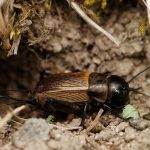Explore Insects
Lorem ipsum dolor sit amet consectetur adipiscing elit. Quisque faucibus ex sapien vitae pellentesque sem placerat. In id cursus mi pretium tellus duis convallis. Tempus leo eu aenean sed diam urna tempor. Pulvinar vivamus fringilla lacus nec metus bibendum egestas. Iaculis massa nisl malesuada lacinia integer nunc posuere. Ut hendrerit semper vel class aptent taciti sociosqu. Ad litora torquent per conubia nostra inceptos himenaeos.
Lorem ipsum dolor sit amet consectetur adipiscing elit. Quisque faucibus ex sapien vitae pellentesque sem placerat. In id cursus mi pretium tellus duis convallis. Tempus leo eu aenean sed diam urna tempor. Pulvinar vivamus fringilla lacus nec metus bibendum egestas. Iaculis massa nisl malesuada lacinia integer nunc posuere. Ut hendrerit semper vel class aptent taciti sociosqu. Ad litora torquent per conubia nostra inceptos himenaeos.
 Backswimmers
Backswimmers
A backswimmer’s easiest identifiable characteristics are its long back legs and oval-shaped body. Their size ranges from 0.2 to 0.6 inches, with females typically being larger than males. Backswimmers are sometimes confused with water boatmen…| Link
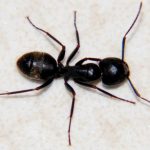 Black Carpenter Ants
Black Carpenter Ants
Black carpenter ants are polymorphic meaning that individuals of the species vary in shape and size; carpenter ants are some of the largest ants in North America. These ants can be distinguished from other black ants by the patch of yellow hairs on their … | Link
 Bumblebees
Bumblebees
Bumble bees are found on all continents except Antarctica and Australia. Because they can handle a range of temperatures, bumble bees are frequently found in temperate regions, with some having even been found at higher elevations in … | Link
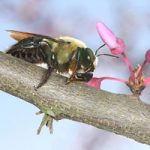 Carpenter Bees
Carpenter Bees
Large carpenter bees have six legs and four wings, and they are typically about one inch in length. Carpenter bees are also glossy on the tops of their abdomens. They typically inhabit forests, woodlands, parks, and gardens, where both flowers and … | Link
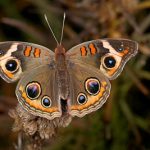 Common Buckeye
Common Buckeye
The common buckeye is in the family Nymphalidae, the brush-footed butterflies that vary in size and color. They have six legs and four wings, and their wingspan ranges from 1.5 to 2.75 inches. Their front wings have orange bars near the leading edge … | Link
 Dragonflies
Dragonflies
Dragonfly have six legs and four wings, which are long and membranous with their hind wings being broader than their forewings. The abdomen has 10 segments and is often brightly colored. They are found on all continents on the globe except Antarctica. | Link
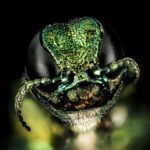 Emerald Ash Borer
Emerald Ash Borer
Emerald Ash borers are usually bright metallic green with copper or reddish iridescence and a linear, cylindrical body where the base of the prothorax is produced as a lobe. They often have a bright copper-red abdomen that becomes visible when elytra and … | Link
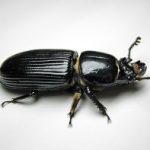 Horned Bess Beetle
Horned Bess Beetle
Horned bess beetles have six legs and four wings. They have large, rounded bodies (1 ½ inch) made up of a hard, shiny black exoskeleton with parallel lines running down its back. They also have a prominent horn on the top of their heads and … | Link
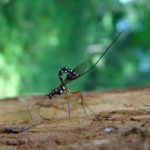 Ichneumon Wasp
Ichneumon Wasp
Ichneumon Wasps are small (0.11-1.5 inch) and slender, with a thin section at the beginning of the abdomen. Antennae are threadlike, with 16 or more segments. Hind trochanters are two-segmented. The ovipositor is in front of the apex of the abdomen … | Link
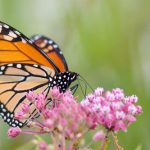 Monarch Butterfly
Monarch Butterfly
Monarch butterflies have striking deep orange wings with black lines and white dots on the borders. The depth of the orange color and the size of the white spots vary; both of these are correlated with migration success. | Link
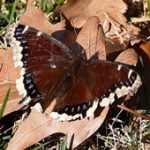 Mourning Cloak Butterfly
Mourning Cloak Butterfly
The outside rim of the mourning cloak butterfly’s wings has a thin border of yellow or white, followed by circles of blue surrounded by black. The rest of their wings are red in color, which fades to brown closer to the body. | Link
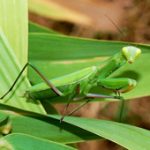 Praying Mantis
Praying Mantis
Praying mantises can be identified by their slender bodies and large, bent front legs. They are usually green or brown, and adults can range from 2-5 inches, depending on sex and species. They have a triangular head with large compound eyes. | Link
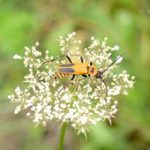 Soldier Beetle
Soldier Beetle
Soldier beetles have long, parallel-sided cylindrical bodies (1.5 mm to 28 mm in length) with a soft exoskeleton and leathery wings. Wings and pronotum are usually brown or black with red, orange or yellow markings; pronotum does not conceal the head. | Link
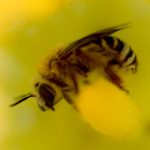 Squash Bees
Squash Bees
Squash Bees are large, fuzzy bee covered in tiny hairs. They are black and yellow, with white and black rims towards the end of their bodies. They distinguish themselves from honey bees with their hairier bodies and shorter antennae. | Link
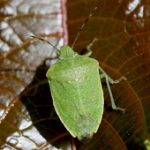 Stink Bugs
Stink Bugs
Stink bugs have a five-pointed, shield-shaped body and five-segmented antennae. They are approximately 7 mm in diameter, and are usually brown or green. When handles or killed they emit a smell. Stink bugs have been found worldwide, except in Antarctica. | Link
 Vespid Wasps
Vespid Wasps
Vespid Wasps are often yellow and black, and have narrow-looking wings (because the wings fold lengthwise when at rest), and notched eyes. They have a stinger and, unlike honey bees, each vespid can sting more than once.| Link
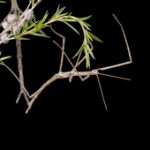 Walkingsticks
Walkingsticks
Walkingsticks have a long, slender body with six long legs. Though some walkingsticks have wings, all but one species in the USA are wingless (Borror & White, 1970). They range in length from 1 to 12 inches and closely resemble a tree twig or stick. | Link

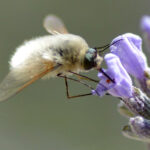 Bee Flies
Bee Flies